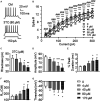Triumeq Increases Excitability of Pyramidal Neurons in the Medial Prefrontal Cortex by Facilitating Voltage-Gated Ca2+ Channel Function
- PMID: 33584297
- PMCID: PMC7876243
- DOI: 10.3389/fphar.2020.617149
Triumeq Increases Excitability of Pyramidal Neurons in the Medial Prefrontal Cortex by Facilitating Voltage-Gated Ca2+ Channel Function
Abstract
Combination antiretroviral therapy (cART) suppresses HIV-1 replication, improves immune function, and prolongs the life of people living with HIV (PLWH). However, cART also induces neurotoxicity that could complicate HIV-induced neurodegeneration while reduce its therapeutic efficacy in treating HIV/AIDS. Triumeq is a first-line cART regimen, which is co-formulated by three antiretroviral drugs (ARVs), lamivudine (3TC), abcavir (ABC), and dolutegravir (DTG). Little is known about potential side effects of ARVs on the brain (including those co-formulating Triumeq), and their mechanisms impacting neuronal activity. We assessed acute (in vitro) and chronic (in vivo) effects of Triumeq and co-formulating ARVs on pyramidal neurons in rat brain slices containing the medial prefrontal cortex (mPFC) using patch-clamp recording approaches. We found that acute Triumeq or 3TC in vitro significantly increased firing of mPFC neurons in a concentration- and time-dependent manner. This neuronal hyperactivity was associated with enhanced Ca2+ influx through voltage-gated Ca2+ channels (VGCCs). Additionally, chronic treatment with Triumeq in vivo for 4 weeks (4 wks) also significantly increased firing and Ca2+ influx via VGCCs in mPFC neurons, which was not shown after 2 wks treatment. Such mPFC neuronal hyperexcitability was not found after 4 weeks treatments of individual ARVs. Further, chronic Triumeq exposure in vivo significantly enhanced mRNA expression of low voltage-activated (LVA) L-type Ca2+ channels (Cav1.3 L-channels), while changes in high voltage-activated (HVA) Cav1.2 L-channels were not observed. Collectively, these novel findings demonstrate that chronic cART induces hyperexcitability of mPFC pyramidal neurons by abnormally promoting VGCC overactivation/overexpression of VGCCs (including, but may not limited to, LVA-Cav1.3 L-channels), which could complicate HIV-induced neurotoxicity, and ultimately may contribute to HIV-associated neurocognitive disorders (HAND) in PLWH. Determining additional target(s) of cART in mPFC pyramidal neurons may help to improve the therapeutic strategies by minimizing the side effects of cART for treating HIV/AIDS.
Keywords: CART; HIV-1; calcium dysregulation; electrophysiology; hyperactivity; neurodegenerative disease; neurotoxicity; voltage-gated calcium channel.
Copyright © 2021 Chen, Al-Harthi and Hu.
Conflict of interest statement
The authors declare that the research was conducted in the absence of any commercial or financial relationships that could be construed as a potential conflict of interest.
Figures








Similar articles
-
Combined chronic blockade of hyper-active L-type calcium channels and NMDA receptors ameliorates HIV-1 associated hyper-excitability of mPFC pyramidal neurons.Neurobiol Dis. 2016 Oct;94:85-94. doi: 10.1016/j.nbd.2016.06.008. Epub 2016 Jun 17. Neurobiol Dis. 2016. PMID: 27326669 Free PMC article.
-
HIV-Induced Hyperactivity of Striatal Neurons Is Associated with Dysfunction of Voltage-Gated Calcium and Potassium Channels at Middle Age.Membranes (Basel). 2022 Jul 28;12(8):737. doi: 10.3390/membranes12080737. Membranes (Basel). 2022. PMID: 36005652 Free PMC article.
-
Aging and HIV-1 alter the function of specific K+ channels in prefrontal cortex pyramidal neurons.Neurosci Lett. 2019 Aug 24;708:134341. doi: 10.1016/j.neulet.2019.134341. Epub 2019 Jun 27. Neurosci Lett. 2019. PMID: 31255727 Free PMC article.
-
Beneficial and Adverse Effects of cART Affect Neurocognitive Function in HIV-1 Infection: Balancing Viral Suppression against Neuronal Stress and Injury.J Neuroimmune Pharmacol. 2021 Mar;16(1):90-112. doi: 10.1007/s11481-019-09868-9. Epub 2019 Aug 6. J Neuroimmune Pharmacol. 2021. PMID: 31385157 Free PMC article. Review.
-
The far-reaching HAND of cART: cART effects on astrocytes.J Neuroimmune Pharmacol. 2021 Mar;16(1):144-158. doi: 10.1007/s11481-020-09907-w. Epub 2020 Mar 9. J Neuroimmune Pharmacol. 2021. PMID: 32147775 Free PMC article. Review.
Cited by
-
Antiretroviral drugs from multiple classes induce loss of excitatory synapses between hippocampal neurons in culture.Front Pharmacol. 2024 Mar 12;15:1369757. doi: 10.3389/fphar.2024.1369757. eCollection 2024. Front Pharmacol. 2024. PMID: 38533258 Free PMC article.
-
Changes in Quality of Sleep, Mood, and Other Neuropsychiatric Symptoms After Switching Dolutegravir/Lamivudine/Abacavir to Darunavir/Cobicistat/Emtricitabine/Tenofovir Alafenamide in a Randomized Study of People With Human Immunodeficiency Virus With Poor Sleep Quality: GESIDA 10418.Open Forum Infect Dis. 2022 Aug 6;9(9):ofac345. doi: 10.1093/ofid/ofac345. eCollection 2022 Sep. Open Forum Infect Dis. 2022. PMID: 36147597 Free PMC article.
-
Effects of integrase inhibitor-based antiretroviral therapy on brain outcomes according to time since acquisition of HIV-1 infection.Sci Rep. 2021 May 28;11(1):11289. doi: 10.1038/s41598-021-90678-6. Sci Rep. 2021. PMID: 34050221 Free PMC article.
-
Editorial: Advances in Understanding NeuroHIV Associated Changes in Neuroimmune Communication in the Combined Anti-retroviral Therapy (cART) Era.Front Neurol. 2021 Oct 5;12:763448. doi: 10.3389/fneur.2021.763448. eCollection 2021. Front Neurol. 2021. PMID: 34675877 Free PMC article. No abstract available.
References
-
- Aouri M., Barcelo C., Ternon B., Cavassini M., Anagnostopoulos A., Yerly S., et al. (2016). In Vivo profiling and distribution of known and novel phase I and phase II metabolites of efavirenz in plasma, urine, and cerebrospinal fluid. Drug Metab. Dispos. 44, 151–161. 10.1124/dmd.115.065839 - DOI - PubMed
Grants and funding
LinkOut - more resources
Full Text Sources
Other Literature Sources
Miscellaneous

